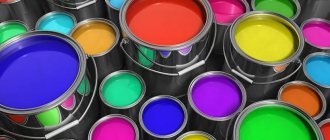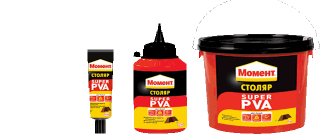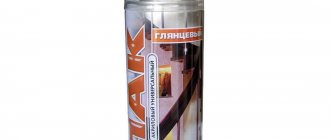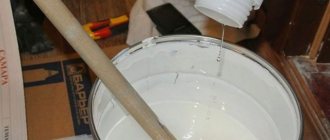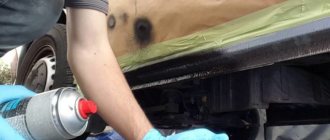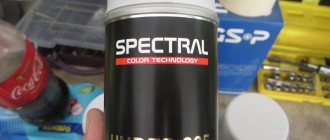In stores you can buy paints and varnishes for any need. They sell varnishes for interior decoration, for outdoor work, for processing various types of surfaces, mechanisms and products, they produce universal varnish mixtures, and special compositions for any materials. For different types of bases, varnish solutions, antiseptic impregnations, wax mixtures, primers and much more are produced with different compositions. Among this variety, it is worth highlighting the varnish for plastic, which is used specifically for this material.
Varnish in cans - properties, scope of application
Modern paints and varnishes are produced not only as standard - in cans, but also in special small containers - cylinders. In them, the coloring matter is compressed under pressure. The spraying unit with a valve mechanism included in the device determines the specifics of its operation.
After pressing the button with the sprayer, the varnish in the can instantly moves to the outlet and is sprayed in the form of a finely dispersed directed cloud. Moreover, the droplets inside it are so small that the sprayed coating is several times thinner than when applied using the standard method - with a roller or brush. This feature makes it possible to achieve the most uniform distribution of the layer of substance on the surface being treated, giving it high aesthetic qualities.
Varnishes produced in this form, as a rule, have a universal component composition, which allows them to be used in various fields:
- Auto body repair.
- Coating of wooden interior items and furniture.
- Finishing in construction.
- Varnishing of souvenirs, toys, etc. utensils
Varnishing of artistic crafts Source youtube.com
- Creation of a protective coating for objects with artistic value.
- Giving resistance and insulation to various elements in electrical engineering.
There are also products for special applications - only for cars or for wood, etc. However, regardless of the composition and purpose, they are all applicable for processing a small surface area. Since for painting walls, floors, and ceilings, it is more advisable to use analogues in large containers - cans, buckets.
Helpful information! Aerosol varnish applied correctly to the surface has good resistance to external destructive factors. These include temperature changes, moisture, dirt, solar radiation, detergents, corrosion, and fungi. Its reliability is so high that it even makes it possible to create electrical insulation in devices.
See also: Catalog of companies that specialize in paints and varnishes and related work
What varnishes are used for plastic
To process a plastic part, you can choose a regular mixture; the container must indicate that the solution can be used for plastic. They produce transparent, colored, glossy and matte compositions, in the form of liquids and aerosols. Certain types of varnish mixtures can be tinted using pigment substances.
It is best to purchase paint and varnish materials in specialized stores that sell plastic products. Such stores very often offer several options for paint and varnish products for this material. In addition, you can contact a store that sells paint and varnish products, where a consultant or salesperson will tell you which product is best to choose for a particular situation.
Important! You definitely need to get acquainted with the composition of the mixture, its properties and purpose. Varnish containing acetone or alcohol is not suitable for processing plastic, because these substances quickly react with polymer materials. Therefore, you need to purchase a water-soluble varnish that uses plain water as a diluent.
Advantages and disadvantages
The use of balloon varnish for various substrates has the following number of practical advantages:
- Quick application - no need to use additional equipment and tools.
- Can be used under any circumstances - in the workshop, on the road, in the parking lot.
- Economic benefit – low cost, lack of consumables.
Universal use of car polish in cans Source ytimg.com
- Minimum time to get it into working condition - the varnish in car spray cans dries within just a few minutes.
- High aesthetic indicators - no smudges or streaks, uniform distribution.
- Versatility in application – both in materials and surface geometry.
- Convenient for application in hard-to-reach areas of the product.
- Quick learning of application technique.
- A variety of compositions according to aesthetic qualities - gloss, matte, shine, with shades and colorless.
There are no downsides to aerosol varnishes as such. Disadvantages can only be associated with a violation of the application technique, the requirements of the instructions, as well as a malfunction of the can itself. For example, sometimes the spray device becomes unusable or the pressure inside drops.
Coating metal utensils with transparent varnish Source stroy-podskazka.ru
Recommendations for varnishing
If you need to varnish small plastic parts, they can be dipped in the composition or treated with a brush. In this case, drops may appear on the lower part of the part, which must be removed before the varnish composition dries. The best option is to use an aerosol, but when using it, you must ensure that the mixture evenly covers the product. To avoid gaps, it is recommended to varnish with at least two layers.
To enhance the depth of shade, make plastic products more impressive and maximally protected, experts recommend varnishing in several layers. It is especially necessary to apply 2-3 layers on translucent and metallized plastic surfaces. Each subsequent layer is applied several hours after the previous coating. The instructions will indicate how long it should take to dry.
Aqueous varnish solutions based on polyurethane usually dry to touch in 2-3 hours, and are ready for use in 1-2 days. However, during the first week you need to treat the varnished product with care; it is not recommended to wet it with water.
Varieties
Depending on the dilution technology used, there are three categories of balloon varnishes:
- H.S. Varnish with a rigid structure. Includes predominantly a non-volatile component and only 10-15% solvent. Therefore, almost all of the applied substance remains on the surface. Characterized by a slight degree of fluidity. Apply in 2 layers.
- MS. It is characterized by greater fluidity due to up to 50% solvents included in its composition. The application technology includes 3 layers. In this case, a pause of 15 minutes is required between procedures.
- 1 TO. Characterized by increased fluidity. The solvent share is more than half. Allows you to reduce painting time.
Varnishes are also classified according to their chemical composition. There are three main types of paints and varnishes of this type:
- Polyurethane.
- Acrylic.
- Nitrocellulose.
Let's look at their features in more detail.
On the packaging, manufacturers indicate what kind of base the varnish has. Source cloudinary.com
Types of aerosol varnishes with descriptions
In order to choose the right product for the material, taking into account the impacts that will occur during its use, it is necessary to study the types of varnishes available on the construction market. The main division is made according to the constituent elements that affect the properties of the coating.
The main division is made according to the constituent elements that affect the properties of the coating.
Polyurethane
Polyurethane spray varnish for wood, transparent or colored, is also used for plastic and metal. The layer serves as a barrier against mechanical shock, chemicals, and water.
When an aerosol is produced, they usually resort to a one-component type, but two-component formulations can also be found, the second component is a hardener that must be added before application.
There is a varnish option consisting of an alkyd resin and a polyurethane base, which gives the layer an extremely durable property. But the product has a minus in the pungent odor.
The layer serves as a barrier against mechanical shock, chemicals, and water.
Acrylic
The acrylic type is harmless to human health and does not contain toxic substances. Therefore, this option is often used for working with furniture; it also has the advantage of not yellowing the surface over time. They emphasize the wood pattern and are not negatively affected by ultraviolet rays.
Water is used as a component in varnishes; due to its evaporation, the polymerization process occurs. The layer has a high level of fixation to the bases. Withstands mechanical stress, but the level of resistance to moisture is low, so you should not choose a varnish for treating surfaces in rooms with high levels of humidity.
The acrylic type is harmless to human health and does not contain toxic substances.
Nitrocellulose (NC 218)
The composition is suitable for interior use, although it includes thinners, resins and colloxylin. Toxic substances may be released during the drying period, so good ventilation is ensured indoors. The drying process does not take much time, about 60 minutes, then the coating becomes safe.
The layer stands out for its beauty and is often chosen for painting wood, also for cars.
The composition is suitable for interior use, although it includes thinners, resins and colloxylin.
Selection criteria – transparent, colored, odorless, glossy, matte
When choosing a varnish for a specific application, the consumer has to solve a series of practical questions - is it possible to find a car varnish that does not produce a strong odor in cans, which is the best of those available on the market - transparent or colored, glossy or matte.
The right choice of varnish is a guarantee of coating quality Source gidpokraske.ru
These problems can be solved based on personal preferences and aesthetic requirements for the surface in each specific case. However, there are also a number of standard recommendations:
- Gloss is preferable for a black/dark object when you need to highlight contrast, transition, or image. The downside is that any flaw becomes clearly visible on the surface.
- The matte surface looks more natural. In addition, they emphasize the style of the product and facilitate the cleaning procedure.
- Transparent varnish does not change the color of the surface or its natural texture. For example, it is used for wood, car wheels and optics.
Colored compounds are used when it is necessary to enhance an existing shade. Moreover, due to the specifics of the structure being created, the applied layer increases the strength of the surface.
- Odorless aerosols allow you to paint indoors when ventilation is impossible or the harm of fumes during drying is obvious. Mostly water-based acrylic varnishes have these characteristics.
Coating a car with spray varnish Source kraski-net.ru
Advice! When choosing a varnish, two parameters are of utmost importance for subsequent use - absorbency and gloss. Water-based products are absorbed shallowly. A highly shiny surface makes the object visually dark.
Why varnish plastic
What is the purpose of plastic varnish? It is used to protect products from adverse environmental influences. In addition, plastic is varnished to enhance its decorative properties so that the surface acquires an attractive glossy shine. And thanks to special pigment additives, you can change the shade of the product, completely change the color of the plastic part, or create an original optical effect.
Thanks to the use of varnish, the life of the plastic is significantly extended, a durable protective layer protects the surface from mechanical damage, and the product becomes protected from chips, scratches and cracks. Not every type of varnish mixture is suitable for treating plastic substrates. Some compositions adhere very poorly to the base and can simply spread over it, while others do not dry at all on the surface. And there are also those that after some time peel off, warp, and begin to stick. Therefore, it is important to know how to choose a varnish for plastic, what properties the solution should have.
Application Features
Paint varnish in cans is used according to the following general instructions:
- Immediately before use, shake the container well.
- Apply the first layer with a quick movement without stopping from a distance of about 30-40 cm.
- 10-15 minutes after it dries, apply the 2nd layer.
- If necessary, several more layers are applied with the obligatory delay of the required time between procedures.
- The surface must be dried before use.
Work on spraying varnish must be carried out at an ambient temperature that complies with the manufacturer's recommendations. As a rule, this is +20 °C.
How to choose and apply autovarnish
After painting the car, it becomes necessary to varnish it. In this case, the question arises about which car polish to choose. Experts have different opinions. Some recommend expensive brands, others believe that you can purchase cheaper options.
Aerosol car spray is divided into 2 types:
- soft (HS);
- solid (MS).
Aerosols dry out in a short time, but during and after work you should protect the surface of the car from dirt and dust.
Type HS must be applied twice. The first layer should be very thin, and the second more solid. This type of aerosol does not leave streaks. It is quite thick and has low viscosity.
Type MS is applied three times to the surface of the car. It has a fluid structure, so it is important to monitor the thickness of the layers to avoid smudges. The period between applications is on average 15 minutes, but this also depends on its composition. Exact recommendations can be read in the instructions.
Varnishing is carried out indoors. After finishing the work you should have a smooth and shiny surface.
Briefly about the main thing
Car varnish in a can significantly speeds up and simplifies the surface varnishing procedure. Thanks to this, it finds wide application - in body repair, painting furniture and interiors, in construction, as well as in the creation of souvenirs, toys, works of art and electrical equipment. Among its obvious advantages are:
- Quick to use.
- Availability in any circumstances.
- Economical.
- Quick return to working condition.
- Versatility to any materials and surface geometry.
- Aesthetics.
- Ease of use in hard-to-reach places.
- Diversity.
No special skills are required to use the can. However, some disadvantages may arise in the operation of the device - breakdown of the atomizer, loss of pressure. Depending on the degree of dilution, varnishes are divided into hard HS, soft MS and high fluidity 1K. In terms of composition, they are alkyd, polyurethane, nitrocellulose, and also mixed. When choosing, you must take into account its aesthetic characteristics, absorbency and shine, store and use it in accordance with the recommended rules.
Ratings 0
Unscented varnishes
Often, the criteria of odorlessness, as well as the environmental friendliness of the composition, become important for selection, especially when it comes to the use of varnished items inside a building. When an item is used by children or people with an allergic predisposition, such a criterion can become decisive.
Varnish is a colorless aerosol and colored, which emits strong unpleasant odors:
- Based on alkyd resin;
- Polyurethane;
- Nitrocellulose.
The properties of nitrocellulose and polyurethane products are high quality, but their composition cannot be called harmless. The alkyd type is also not environmentally friendly.
The most harmless types are acrylic-based varnishes; they are created using water, which allows the compositions to be used without fear of releasing toxic elements, because there are none.
When an item is used by children or people with an allergic predisposition, such a criterion can become decisive.

